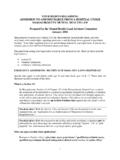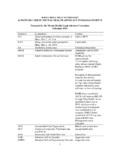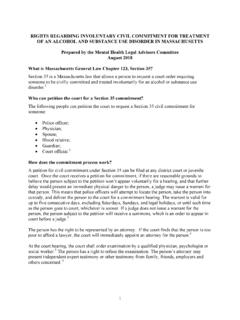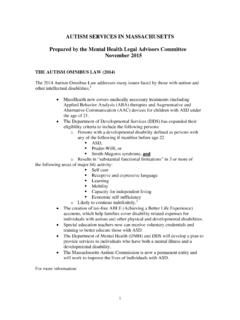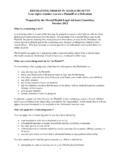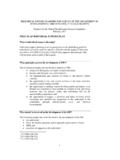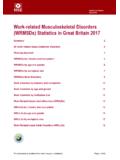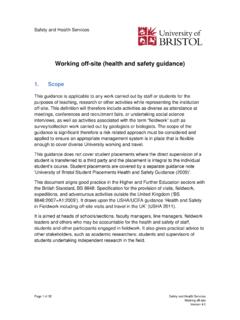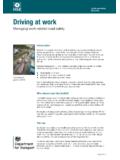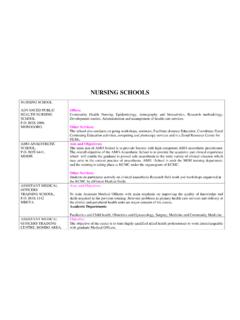Transcription of RIGHTS OF YOUTH WITH MENTAL HEALTH NEEDS …
1 RIGHTS OF YOUTH WITH MENTAL HEALTH NEEDS regarding education AND special education IN MASSACHUSETTS Prepared by the MENTAL HEALTH Legal Advisors Committee December 2011 TABLE OF CONTENTS 2 Referral .. 8 Evaluation .. 9 IEP/ Services in School .. 13 IEP Placement 21 Transition Planning .. 27 Chapter 688 Referral .. 30 After School Programming .. 32 School Disciplinary Actions .. 35 Due Process 42 50 Educational Services in Institutional Settings .. 51 RIGHTS regarding a 52 special education and Autism .. 54 MCAS and Students with Disabilities .. 57 Children and 59 Positive Behavioral Interventions and Supports (PBIS) and Socio-Emotional Learning (SEL).. 60 Schools and Rosie D. Implementation .. 63 Homeless Children and education .. 67 Foster Children and education .. 71 College Age Students with Disabilities .. 73 1 Eligibility What kind of educational services are available under the law for YOUTH with disabilities?
2 Section 504 and the Individuals with Disabilities education Act (IDEA) are both federal laws that can help secure a range of services for children with special education NEEDS . It is important to know the differences between them when pursuing special education services. Resources: SPEDW atch, IEP or 504 Plan: What difference does it make?, How can Section 504 be used by students? Section 504 of the Rehabilitation Act of 1973 covers a broader range of disabilities than IDEA, meaning that more children are entitled to protections under it than are under Section 504 protects all people with a disability who 1) have a physical or MENTAL impairment that substantially limits one or more major life activity, 2) have a record of such an impairment, or 3) are regarded as having such an Section 504 is an anti-discrimination act, meaning that it aims to remove barriers to equality that stand between disabled and non-disabled people.
3 In special education programs, the services and accommodations available under Section 504 aim to bridge these Any programs that receive federal funding ( , all public schools) are required to recognize Section Services available under Section 504, often provided through a document known as a 504 plan, should be tailored to individual students with disabilities to meet their educational NEEDS as equally as students without disabilities. Some students protected under Section 504 may not need additional services beyond education in regular classrooms. However, other students might stay in regular education classrooms but need supplementary 1 S. James Rosenfeld, Esq., Edlaw, Inc., Section 504 and IDEA: Basic Similarities and Differences 2, 2 29 794; 42 12102. 3 29 794; S. James Rosenfeld, Esq., Edlaw, Inc., Section 504 and IDEA: Basic Similarities and Differences 2, 4 Department of education , Office for Civil RIGHTS , Free Appropriate Public education for Students with Disabilities: Requirements Under Section 504 of the Rehabilitation Act of 1973 1 (2007), 2services or special accommodations.
4 Still others may need to be taken out of the regular education classroom and placed in a special education program with other related Resources: OCR, Protecting Students With Disabilities, Frequently Asked Questions About Section 504 and the education of Children with Disabilities, What is the Individuals with Disabilities education Act (IDEA)? The Individuals with Disabilities education Act (IDEA) mandates the provision of services to children with a specific range of disabilities. In Massachusetts, the following disabilities may make a child eligible for IDEA services: autism, developmental delay, intellectual impairment, sensory impairment (including hearing or visual impairment, or deaf/blind), neurological impairment, emotional impairment, communication impairment, physical impairment, HEALTH impairment, or specific learning In addition to proof of one of these disabilities, evaluators must be able to prove that because of the disability, the child is unable to make effective progress in school without special education Progressing effectively is defined in Massachusetts Children entitled to services under IDEA are required to receive an individualized education program (IEP).
5 What is an IEP? An Individualized education Program or IEP outlines a child s NEEDS and details the special education and related services that he should receive in the most appropriate learning environment. Depending on the child s individual NEEDS , educational services under an IEP include varying combinations of special education and related services, 5 Department of education , Office for Civil RIGHTS , Protecting Students With Disabilities: Frequently Asked Questions About Section 504 and the education of Children with Disabilities, 6 DESE, IEP Process Guide (2001), 7 DESE, IEP Process Guide (2001), 8 Progress effectively in the general education program shall mean to make documented growth in the acquisition of knowledge and skills, including social/emotional development, within the general education program, with or without accommodations, according to chronological age and developmental expectations, the individual educational potential of the student, and the learning standards set forth in the Massachusetts Curriculum Frameworks and the curriculum of the district.
6 The general education program includes preschool and early childhood programs offered by the district, academic and non-academic offerings of the district, and vocational programs and activities. 603 CMR (17). 3modifications to programs, supplementary services and accommodations, or supports to school staff in both regular education and separate classroom settings. What is FAPE? Any person with a disability is entitled to what is known as a free appropriate public education (FAPE). FAPE generally provides students with disabilities with the right to an education that meets their NEEDS in the public school setting and is of no cost to them or their families. However, FAPE is defined slightly differently in Section 504 and in IDEA. Section 504 defines FAPE to include special or regular education and related services, while IDEA counts only special education and related In addition, FAPE under IDEA must conform to a student s Resources: SPEDW atch, What Does FAPE Really Mean?
7 , Should I pursue special education and how would I do so? If a parent or guardian thinks that a child may have a disability that is preventing him from making effective progress in school, they might first request non- special education classroom accommodations. If these efforts are still not helping the child, it may be advisable to pursue special education services. The first step in this process is to make referral to the school district, which must then pursue a special education evaluation. Parents, guardians, teachers or other school staff all may make referrals for an evaluation. Once a referral has been made, the school must contact the child s parents to seek consent in writing before the evaluation process may After parents give written consent, the evaluations must be completed within 30 The school district also should send a copy of the Parent s Notice of Procedural Safeguards to parents before the process begins.
8 Resources: DESE, Parent s Notice of Procedural Safeguards, DESE, Eligibility Flow Chart, DESE, A Parent s Guide to special education , 9 34 CFR 10 34 CFR 11 The Federation for special NEEDS and DESE, A Parent s Guide to special education 12, 12 The Federation for special NEEDS and DESE, A Parent s Guide to special education 13, 4 How do I advocate for services for my mentally ill child if not child is not displaying problems in school? If you feel that your child s MENTAL illness is negatively affecting his education , even if he is not displaying problems in school, then there are steps you can take to advocate for your child. It is important to document the behaviors in the home, and preferable to have this done by a clinician or doctor. You or the clinician must then determine if there is a connection between those behaviors and educational progress, and, if so, explain the relationship.
9 It is also important to look to see if there is really no evidence of behavioral or other problems in school. Reviewing your child s school records may provide you with additional information. It is also possible that your child may be displaying these behaviors in some capacity at school, even if not in the classroom, so it is important to look at other settings, like transportation to and from school, afterschool programming, and homework time at home. Documenting the services tried in the home will also provide evidence as to the need for additional supports during the school day, if the services at home are not effective. It is important for schools to be aware of a child s MENTAL HEALTH NEEDS , even if the child is not displaying problems in school or does not qualify for special education . Teachers and other school staff members can provide a more supportive learning environment if they are aware of special behavioral NEEDS .
10 Parents and guardians should determine what services are available at a child s school, which is responsible for providing them, and how to access them. MENTAL HEALTH services in public schools vary greatly by school and may include in-school programs, services from outside providers (including Community Service Agencies or CSAs), and School-Based HEALTH MENTAL HEALTH professionals who work with schools may include guidance counselors, social workers, adjustment counselors, and psychologists. Approaching teachers, school counselors or psychologists, and other school personnel to discuss a child s MENTAL HEALTH NEEDS may be useful in getting the appropriate evaluations and in-school services and establishing a mutually beneficial relationship with the school. Parents do not have to disclose any information and should only relay what they feel comfortable discussing. School staff members must keep confidential any information relayed to them by a child s doctor or Resources: 13 Boston Bar Association, The Parents How-To Guide to Children s MENTAL HEALTH Services in Massachusetts 86 (2d ed.)

